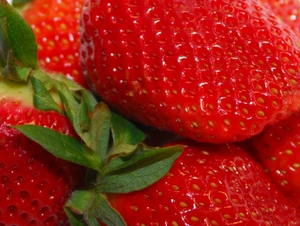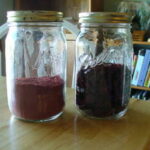When your garden harvest, or produce purchase, turn out to be more than you can reasonably handle there are ways to keep that food from going to waste! Beyond giving food away, canning, and gorging on what may have been your favorite food before it took over your life, you can also create organic fabric dyes.
I was inspired in my search for the best method to do this because of all the toxic chemicals involved in treating and dying things I come in contact with every day. Getting organic, all-natural fiber based materials would let me create the colors I wanted, without exposing myself or family to the chemicals typically used in the dyeing process. The fact that my strawberries and roses came too early and too fast, so I had a lot of natural ingredients to work with, helped motivate me and allow me to make some mistakes. Now my daughter is decked out in hand dyed clothing, and I can dye my own wooden beads and objects for other crafts.
Excess strawberries, various fruit peels, flower petals, and some herbs can be used to make perfect shades of fabric. There are some foods and flowers that work better than others, but please experiment and combine ingredients until you find exactly the colors you are looking for. Your imagination, resources, and time are the only limitations!
First, some basic suggestions to help achieve success. It is best to work with natural fabrics such as organic cotton, linen, wool, and silk. Like with your choices for color sources, do not be afraid to experiment with your favorite materials. Please test each batch of dye with a small piece of fabric before committing to a larger piece. That way if you need to adjust the color strength or combination you have not destroyed a favorite or expensive fabric. This still stands if dying spun wool other spun natural fibers you plan on selling or using in later projects. Test a small piece or section before jumping in with both feet.
Instructions:
1. Pre-wash your fabric to be certain any contaminants or impurities are removed.
2. Soak the fabric in a large container of water.
3. Prepare your color source by chopping up your food into small pieces. However, do not make the pieces so small that you will be unable to strain them out of the liquid later. Some foods, such as onions and plums, will only require the use of the skins. I have listed some suggested color sources below.
4. Prepare the dye by placing water and the color source in a large pot. I use a ratio or two parts water to one part source. For example four cups of water with two cups of strawberries. After you do this a few times you will decide which colors you need to adjust the ratio for darker or lighter color results.
5. Boil the water and color source for around an hour. Again, you can adjust this time to further customize the color results. Boiling longer can make the dye a little strong, a shorter boil time can result in a pastel or lighter shade.
6. Strain the color source from the colored water. You can either strain into another pot or use a mesh strainer to gather any particles from the hot pot.
7. If your color source is a fruit or vegetable add salt to the water, around 1/4 of a cup per 4 cups of water you began with. If your color source is a flower or other plant material, add 1 cup of vinegar for each 4 cups of water.
8. Add your soaked fabric to the pot of warm colored water.
9. Bring the liquid back up to a boil, stirring the fabric through the colored water regularly.
10. Allow the cloth to simmer in the pot for around an hour.
11. Remove the pot from the heat.
12. Let the fabric remain in the dye for as long, or short, of a time as you wish. Again, the longer you leave the fabric in the dye the strong the result, the shorter the time the lighter the result. I do not recommend soaking the fabric for more than two hours, because by that point the dye in the water has likely done all that it can and will not further darken the fabric. Although others swear by leaving the fabric to soak overnight, I have not seen any darkening in my experiments past that two hour mark, although it cannot do any harm.
13. Rinse and gentle hand wash the dyed fabric in cold water twice. I suggest using a gentle detergent on the second wash to remove any of the vinegar or salt and to be sure that the color will not bled in later washes.
14. Rinse the fabric once more, then lay the material flat and let the freshly dyed fabric dry.
Now some suggestions for color sources, though I still recommend trying out some of your favorite foods or flowers. Do not be afraid to experiment! You can blend materials as well as the made dyes in order to achieve the exact shade you want.
Color Source Suggestions:
- Strawberries, cherries, and pink roses will result in a nice pink, red onion peels will leave a muted reddish purple color, and plum skins will provide a hot pink dye.
- Raspberries, blackberries, cranberries, red grape skins, and beets will result in various shades of red, while lavender flowers will produce a gentle purple.
- Tumeric, tansy, or goldenrod will result in a vibrant yellow color; while yellow onion skins, lemon peel, dandelion, orange peel, carrot tops, or cumin provide a more mellow shades of yellow.
- Chili, paprika, and other spice powders will result in a muted shade of the powder you see.
- Dark green vegetables like spinach and sorrel will provide a nice shade or green, ferns and lighter leafy greens will result in more subtle shades.
- Coffee, dark teas, cinnamon, birch bark, and walnut shells will result in shades of brown.
- Red cabbage, blueberries, elderberries, mulberries, hyacinth, cornflower, and black beans will leave you with shades varying from blue to purple.
Do not stop with fabric. You can use the same dyes made here to color eggs, paper, wooden beads, and much more. For more ideas on color sources I highly recommend visiting Pioneer Thinking, which lists various plants, spices, and foods by the colors of the dye they can produce. The site even offers suggestions of ingredient combinations. Plants for a Dye Garden on Garden Guides also offers some suggestions of useful plants for making dye, and basic insight in how to grow them.





